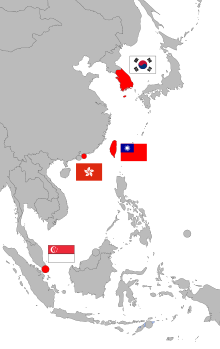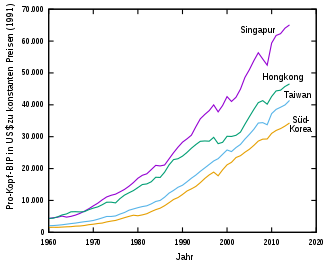Four Asian Tigers
![]()
This article or subsequent section is not sufficiently supported by evidence (e.g., anecdotal evidence). Information without sufficient evidence may be removed in the near future. Please help Wikipedia by researching the information and adding good supporting evidence.
Tiger States collectively referred to South Korea, Singapore, Taiwan and Hong Kong, and later Thailand, Malaysia, Indonesia and the Philippines. These four Southeast Asian economies are also literally referred to as the "Four Little Dragons of Asia" (Chinese 亞洲四小龍 / 亚洲四小龙, pinyin Yàzhōu sì xiǎolóng) in Chinese-speaking economies; this term has also become common in Korean, Japanese and French. The term, coined in the 1980s, refers to the fact that these economies rose from developing to developed states thanks to high economic growth. The term was coined in reference to the powerful energy of a tiger leaping to indicate the high dynamics of the economic upswing.
Occasionally, the designation "tiger states" is also used for the 13 states on whose national territory still rest populations of the tiger are.

The Four Tiger States
Phases of economic development
Economic development can be divided into phases: In the initial stage, states were economically underdeveloped, including e.g. resource poverty, low agricultural viability and high illiteracy rates, and were therefore dependent on the import of industrial products. To end this deplorable state of affairs, a policy of import-substituting industrialization was pursued by attracting light industry, which was primarily interested in the low wages, little protection for workers, and lack of trade unions. Business-friendly economic policies favored low-cost production with special economic zones and open cities. During this period, the development from an agricultural to an industrial state took place, similar to the structural change within the 3-sector model of the national economy, even if the social conditions improved only slightly or even worsened.
Depression
This phase was followed by a depression of the economy in the 1990s, which was caused by the loss of previous locational advantages due to the emergence of trade unions and the associated social demands or even comparable - or even more favourable - economic conditions in neighbouring countries. The response to this crisis was the development of modern industry, no longer founded by foreign investors. This modern economy now offered higher wages along with social security, and in many cases brought with it growth in the service sector. Critical to the development of modern industry is investment and the development of universities, openness to international trade and political stability. In South Korea, Taiwan and, to a limited extent, Hong Kong, the political system was democratised during this phase.
Asia crisis
→ Main article: Asian crisis
The withdrawal of speculative funds in Thailand and later in Malaysia, South Korea, Indonesia and the Philippines led to the Asian crisis in 1997, which also hit the tiger economies hard.
Problems
In the tiger economies, a low-wage industry developed first, and later almost exclusively the high-tech industry, which is tantamount to a monoculture, which in turn entails risks vis-à-vis crises. In addition, dependencies on a few raw material and sales markets can quickly develop.
Likewise, industry grows almost exclusively in the cities, which is why the rural population migrates to the cities (rural exodus). The response to this has been the construction of numerous relief and residential cities, most of which were planned and built by the state. A typical example is the Sha Tin district in Hong Kong, where a residential city for more than half a million people was built.
Due to the high population growth in the cities until the 1990s, the infrastructure was heavily burdened. At the moment, population development in the territorial states of South Korea and Taiwan is characterized by the increasing importance of the capital. Sudogwon, the metropolitan area of Seoul, is the second largest metropolitan area in the world. Almost half of all South Koreans live in and around the capital. About a third of all Taiwanese live in the Taipei metropolitan area. In contrast, rural areas are already suffering from heavy out-migration. What makes this so explosive is the simultaneous natural decline of the population in these areas that has begun since the 2000s. Meanwhile, many other centers such as Kaohsiung and Busan are already suffering from population loss. Also, until the 1990s, many provincial cities in East and Southeast Asia did not even have subway networks, whereas the capital cities or financial centers had very dense and sophisticated networks.
One challenge is to ensure that industrial development does not widen the gap between rich and poor too much and that the development into an industrial state does not happen at the expense of social development.
One problem affecting the four tiger economies is a sharp drop in birth rates since the 1990s. Fertility rates in 2005 were 0.96 children per woman in Hong Kong, 1.08 in South Korea, 1.12 in Taiwan and 1.25 in Singapore. Thus, population numbers are predicted to decline in the coming decades. At the same time, the number of elderly people is rising more rapidly than anywhere else in the world. If this trend continues, the tiger economies will face even greater demographic problems than the Western European states. Unlike the territorial states, the city states of Singapore and Hong Kong would still be able to compensate for these problems through immigration. Since society in Taiwan and especially in South Korea is highly homogeneous, it is questionable whether increased immigration will take place.
.jpg)
Taipei, capital of Taiwan

Singapore

Growth in per capita gross domestic product at constant prices in the tiger economies over the period 1960 to 2014.
.jpg)
Seoul, capital of South Korea

Hong Kong
Explanation of the development phases
The flying geese model is a model of the economic development of some countries in the Asian region, especially the tiger economies. These Asian countries are compared with the flight behavior of the flying geese: Like the geese, one country, in this case Japan, led the other flying geese. The economic success of these fellow fliers then developed analogously to the leading goose.
The following chronological sequence is typical:
- Initially, the country's dependence on imports
- Import substitution through the introduction of light industry
- thus low domestic demand for imported goods
- Export promotion through labour-intensive production
- Import restrictions (import duties) of the buyer countries; rising wages and thus competition from other low-wage countries
- Coupling import substitution and export promotion through capital- and human capital-intensive production
- rising wages and competition from other emerging markets; low competitiveness in terms of innovation
- Intensification of high-tech industries to the point of competitiveness with industrialized countries
Questions and Answers
Q: What are the Four Asian Tigers or Dragons?
A: The Four Asian Tigers or Dragons are the highly developed economies of Hong Kong, Singapore, South Korea, and Taiwan.
Q: Why are the Four Asian Tigers known?
A: The Four Asian Tigers are known because they had very high growth rates (they became rich very fast) and fast industrialization between the early 1960s and 1990s.
Q: Are the Four Asian Tigers currently well-developed countries?
A: Yes, all four Asian Tigers are currently well-developed economies (developed countries).
Q: How is the work force of the Four Asian Tigers compared to others in the region?
A: The work force of the Four Asian Tigers is highly educated and productive compared to others in the region.
Q: What is the economic success of South Korea and Taiwan known as?
A: The economic success of South Korea and Taiwan is known as the "Miracle on the Han River" and the "Taiwan Miracle" respectively.
Q: How did the Four Asian Tigers accomplish rapid economical growth?
A: The Four Asian Tigers accomplished rapid economical growth by exporting (selling) products to rich industrialized nations.
Q: Were the Four Asian Tigers democratic nations from the start?
A: No, each nation was not a democracy, and people were not very free in the early years, but all of these countries later became freer, and people now think Taiwan and Korea are liberal democracies.
Search within the encyclopedia